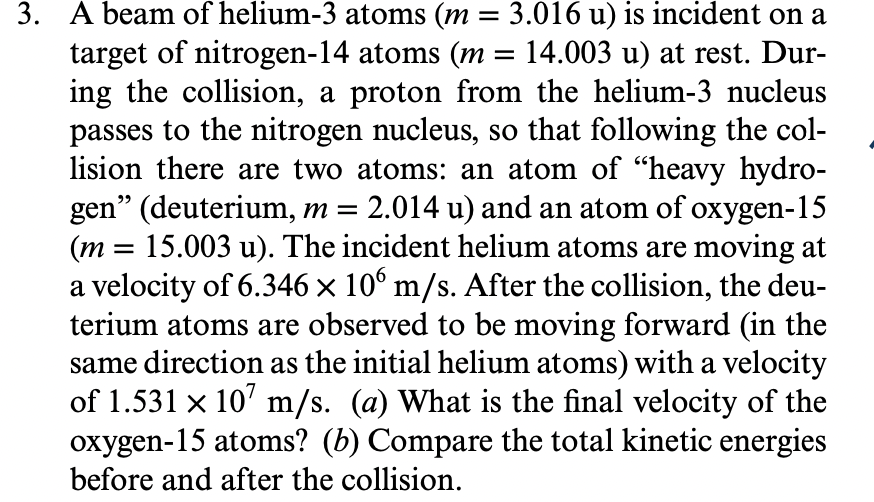A beam of helium-3 atoms (m = 3.016 u) is incident on a target of nitrogen-14 atoms (m = 14.003 u) at rest. Dur- ing the collision, a proton from the helium-3 nucleus passes to the nitrogen nucleus, so that following the col- lision there are two atoms: an atom of “heavy hydro- gen" (deuterium, m = (m = 15.003 u). The incident helium atoms are moving at a velocity of 6.346 × 10° m/s. After the collision, the deu- terium atoms are observed to be moving forward (in the same direction as the initial helium atoms) with a velocity of 1.531 x 10' m/s. (a) What is the final velocity of the oxygen-15 atoms? (b) Compare the total kinetic energies %3| 2.014 u) and an atom of oxygen-15 before and after the collision.
A beam of helium-3 atoms (m = 3.016 u) is incident on a target of nitrogen-14 atoms (m = 14.003 u) at rest. Dur- ing the collision, a proton from the helium-3 nucleus passes to the nitrogen nucleus, so that following the col- lision there are two atoms: an atom of “heavy hydro- gen" (deuterium, m = (m = 15.003 u). The incident helium atoms are moving at a velocity of 6.346 × 10° m/s. After the collision, the deu- terium atoms are observed to be moving forward (in the same direction as the initial helium atoms) with a velocity of 1.531 x 10' m/s. (a) What is the final velocity of the oxygen-15 atoms? (b) Compare the total kinetic energies %3| 2.014 u) and an atom of oxygen-15 before and after the collision.
College Physics
1st Edition
ISBN:9781938168000
Author:Paul Peter Urone, Roger Hinrichs
Publisher:Paul Peter Urone, Roger Hinrichs
Chapter31: Radioactivity And Nuclear Physics
Section: Chapter Questions
Problem 75PE: The purpose of this problem is to show in three ways that the binding energy at the election in a...
Related questions
Question

Transcribed Image Text:3. A beam of helium-3 atoms (m = 3.016 u) is incident on a
target of nitrogen-14 atoms (m = 14.003 u) at rest. Dur-
ing the collision, a proton from the helium-3 nucleus
passes to the nitrogen nucleus, so that following the col-
lision there are two atoms: an atom of "heavy hydro-
gen" (deuterium, m = 2.014 u) and an atom of oxygen-15
15.003 u). The incident helium atoms are moving at
(m
a velocity of 6.346 × 10° m/s. After the collision, the deu-
terium atoms are observed to be moving forward (in the
same direction as the initial helium atoms) with a velocity
of 1.531 x 10' m/s. (a) What is the final velocity of the
oxygen-15 atoms? (b) Compare the total kinetic energies
before and after the collision.
Expert Solution
This question has been solved!
Explore an expertly crafted, step-by-step solution for a thorough understanding of key concepts.
This is a popular solution!
Trending now
This is a popular solution!
Step by step
Solved in 3 steps

Knowledge Booster
Learn more about
Need a deep-dive on the concept behind this application? Look no further. Learn more about this topic, physics and related others by exploring similar questions and additional content below.Recommended textbooks for you

College Physics
Physics
ISBN:
9781938168000
Author:
Paul Peter Urone, Roger Hinrichs
Publisher:
OpenStax College

Modern Physics
Physics
ISBN:
9781111794378
Author:
Raymond A. Serway, Clement J. Moses, Curt A. Moyer
Publisher:
Cengage Learning

College Physics
Physics
ISBN:
9781285737027
Author:
Raymond A. Serway, Chris Vuille
Publisher:
Cengage Learning

College Physics
Physics
ISBN:
9781938168000
Author:
Paul Peter Urone, Roger Hinrichs
Publisher:
OpenStax College

Modern Physics
Physics
ISBN:
9781111794378
Author:
Raymond A. Serway, Clement J. Moses, Curt A. Moyer
Publisher:
Cengage Learning

College Physics
Physics
ISBN:
9781285737027
Author:
Raymond A. Serway, Chris Vuille
Publisher:
Cengage Learning

University Physics Volume 3
Physics
ISBN:
9781938168185
Author:
William Moebs, Jeff Sanny
Publisher:
OpenStax


An Introduction to Physical Science
Physics
ISBN:
9781305079137
Author:
James Shipman, Jerry D. Wilson, Charles A. Higgins, Omar Torres
Publisher:
Cengage Learning